
Reef Alarmists Find What They Need to Find
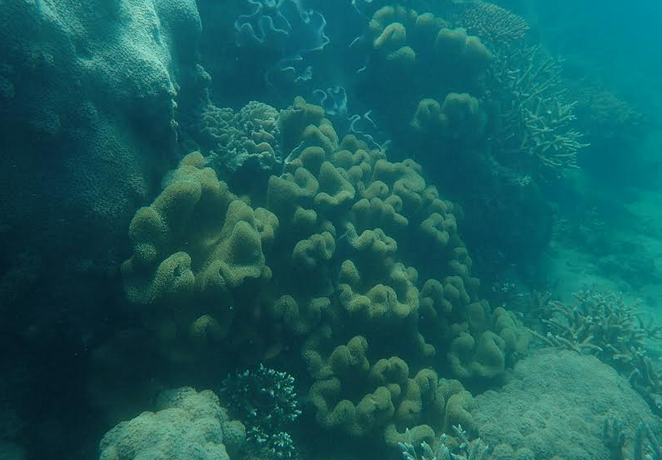
Some 50 years ago an outbreak of coral eating crown-of-thorns (CoT) starfish on the Great Barrier Reef (GBR) came to the attention of biologists. Today, after a half-century and hundreds of millions of dollars in research, during which time the starfish have blossomed and declined numerous times, there is still no evidence to indicate such population blooms are not natural events, as they are with other starfish species all over the world.
The researches did learn something of value, however: alleged “threats” to the GBR attract media attention, generous research funding and public recognition for researchers.
During the first couple of decades of this period Reef threats were just an added boost to basic research, which was focused on discovering new understanding of these oldest and richest of natural communities. However, by the 1990s, with the rise of environmentalism and the green political movement, eco-threats began to eclipse basic research in funding and research interest. Today, we have a whole generation of researchers whose entire experience of the Reef has been in the context of finding, investigating and promoting environmental “threats”. They tend to perceive every fluctuation of nature as evidence.
During this entire time not a year has passed without news reports bannering some dire and imminent threat to the GBR being declared by people always described as “reef experts”. However, none of these purported perils has ever proven to be other than temporary; and, no matter how often the cry of “Wolf!” is repeated, it never seems to provoke any questioning from journalists. Meanwhile, every day thousands of visitors continue to be entranced by the abundance and beauty of life they see on the Reef.
Dynamic nature of reefs
Reefs are highly dynamic and variable communities. Across the Pacific healthy reefs might be comprised of a half-dozen corals and 100 species of fish (in the Eastern Pacific) to 500 corals and 1500 species of fish (in the Western Pacific). Large differences are also common between nearby reefs and even on the same reef from year to year.
Occasional devastation and recovery from storms, floods, bleaching, upwelling and starfish plagues are also common. Even a good rain during an especially low tide can be devastating to exposed corals. A map of tropical cyclone tracks over recent decades depicts a tangled web across the GBR. Every one of those storms left behind a trail of thousands of hectares of broken coral, plus heavy blankets of silt and stirred-up sediments.
Varying abundance of the distinctive spines of the CoT starfish in Reef substrates indicate that this, too, is nothing new but has been going on for thousands of years. There is, in fact, good reason to suspect that the starfish actually play a valuable role in maintaining coral diversity by pruning back the faster growing branching and plate-like species which tend to overshadow the longer lived, but slower growing, more massive forms. The current activity of spending millions of dollars to employ teams of divers to individually kill starfish is somehow all too reminiscent of Mao’s initiative to reduce houseflies by having millions of peasants kill them with flyswatters, and it seems to be achieving similar effectiveness.
Bleaching is also nothing new; it’s just that it has only been recently noticed. The characteristic scars it leaves in coral skeletons are readily apparent for millennia in recent corals, just as they are in fossil corals from millions of years ago. For those with limited direct experience of reefs and primed by belief in a litany of hypothetical anthropogenic threats, every fluctuation of nature provides abundant evidence which appears to confirm their concern.
Fringe conditions of inshore reefs
Many reefs, and especially the most easily accessible coastal reefs, are often subject to natural extremes of temperature, floods and storms. Not uncommonly this results in extensive coral mortality. The huge geographic area and range of environmental conditions encompassed within the GBR means that damaged areas are a common occurrence somewhere in the system. However, these are always assumed to be unprecedented, unnatural and devastating. When this is then followed by what is in actuality a normal rapid recovery it is inevitably presented as a surprise. Somehow the repeated process is never sufficient to alter belief to better conform with real world experience.
Rise of modelling
A significant factor in the growing detachment of environmental science from empirical reality has been the rise in popularity of computer modelling and a decline in real-world observation. The latter tends to be uncomfortable to obtain, the results are often messy, frequently don’t support the desired narrative and present a risk of independent examination. By contrast, computer modelling can be done in comfort during office hours, presents an aura of advanced expertise and mathematical certainty, can be “adjusted” to give a desired result generally inaccessible to independent examination. As a last resort such projected models can even be claimed as “intellectual property” which can’t be revealed because of commercial confidentiality considerations. Never mind if they have been entirely developed with public funds. That never seems to be a consideration.
The truth is that although computer modelling has indeed proven a powerful tool for analysis and prediction, this is true only where good input data are available, the dynamics are well understood, and the models are mathematically verified as well as empirically validated. Unfortunately, none of this is true for most environment modelling and the results at best amount to nothing more than the modeler’s opinion of an untested possibility.
In the few instances where such models have been subject to independent examination, they have been revealed as poorly documented, amateurish hacks of widely available public domain programs being misleadingly presented as high-quality original development.
Effects of water quality and climate change
In regard to GBR water quality and runoff, the following from a 2006 study by Professor Robert Carter provides a good summary:
…the ambition to halt and reverse the decline in water quality entering the reef is fundamentally unsound, for the very good reason that no regional decline in reef water quality from its natural state has ever been detected, despite intensive research towards that end.
He goes on to say,
This paper reviews the available data regarding nutrient contents in the Tully River, north Queensland, which is cited as the best (available) evidence for human-related changes in nutrient export from (GBR) catchments. It is shown that the claim of human-related nutrient enrichment in the Tully River, and regionally, is without substance. No detectable trends in GBR water quality have occurred since systematic measurements were first started in the 1980s.
In short, there is no evidence of any decline in GBR water quality and no reason to expect any. In fact the opposite is true in that there has been a decline in the use of fertilizer and agrichemicals in the GBR catchment over recent decades with traces of pesticides at their highest well below any levels known to be harmful while nutrient runoff to the Reef is orders of magnitude less than natural fluctuations stemming from internal waves from the open ocean and which are considered to be beneficial. As for sediment runoff, the inshore waters are blanketed by a natural accumulation of thousands of years of wet season runoff from an ancient dusty landmass. This is kept suspended much of the time by wave action on a windy coast. The idea of increased sedimentation since European settlement is entirely based on speculation and computer modelling. By way of contrast, it is easily observed that heavy wet season runoff from cropland and improved pasturage is usually clearer than runoff from either rainforest or other natural vegetation, both of which tend to provide less groundcover. Real-world observation actually suggests that, if anything, there may well be less sediment runoff now than before European settlement.
In any event, the corals on nearshore reefs are species adapted to turbid conditions and their frequent mortality from runoff is entirely due to the fresh water it brings and nothing to do with sediments, nutrients or agrichemicals.
Bowen Reefs
Currently there is a plan to greatly increase the environmental demands and restrictions on primary producers in the GBR catchment. This is claimed to be necessary to address declining water quality and dying reefs. A key element in the public campaign to press for the increased environmental regulations, and of course, for increased funding to “save the Reef,” has been photos of exposed reefs at low tide near Bowen which are said to have been killed by the effects of climate change and declining water quality. The picture below is typical.
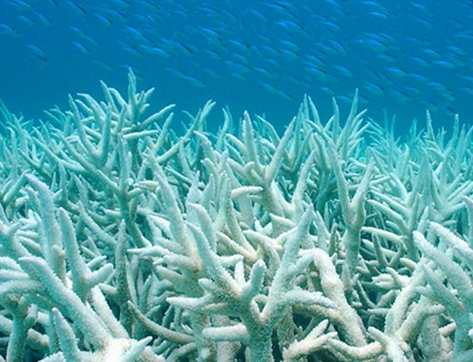
What gives these images special impact is comparison images in the book by Saville-Kent, The Great Barrier Reef of Australia: its products and potentialities, published in 1893, and are said to be in the same location. However, it should be noted that the exact location of the early photos and the actual tide level at the time they were taken is unknown. It should also be noted that a flood event stemming from a cyclone in 1918 is reported to have killed all the corals in this area.
More recently a study by Clark et al. published in 2016 found that isotopic dating of the dead corals sampled from the assumed locations of the historical photographs coincided with major flood events in 1990–1991 at Bramston Reef and 1970 and 2008 at Stone Island. Clark et al. were also careful to mention the various uncertainties and lack of evidence in attributing the cause for an apparent low level of coral recovery in 2012 when their survey was conducted. However, all this has been ignored in favour of the dramatic photo comparisons which have been presented as proof of the Reef dying from climate change and pollution.
Earlier this year, Dr. Jennifer Marohasy visited Bowen and was impressed by the beautiful corals she saw. With support from the Institute of Public Affairs she returned in late August with an underwater videographer and a drone survey crew to document the actual condition of the reefs in the area. Professor Peter Peter Ridd and I were invited to offer our assessment, and this is what I observed:
Stone Island is an irregular shaped island about 1.5 Km across and a similar distance off the coast at Bowen. It is a mix of rocky outcroppings and hills up to about 25m in height intermixed with considerable low-lying areas of sand and salt pans.
Stone Island (below), as seen from the West on Flagstaff Hill in Bowen.
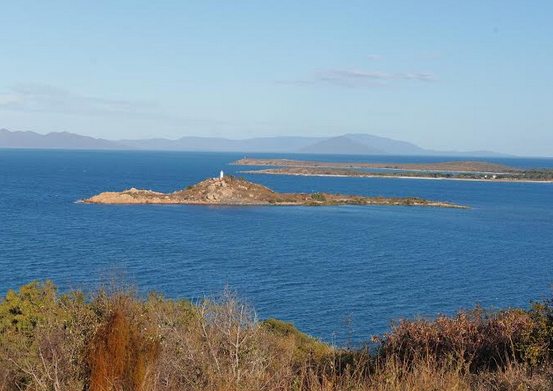
The 2012 survey was located near the middle of an extensive reef flat several hundred meters wide extending from the southern side of the island. The location depicted for the 2012 study transect was perpendicular to the shore and extended to about 30-40m from the outer edge of the reef flat where we found there was a healthy fringing reef stretching for nearly 2 Km in length. As this area is exposed to the prevailing strong south-easterly winds of this area of coast, breaking waves on the reef edge and turbidity limit access much of the time. We were fortunate to have several hours of calm on two days while we were there. Here is what we saw:
- Extensive healthy reef along S to SE side of Stone Island
Healthy reef like this (pictured below) extends for about 2 Km along the S to SE side of the island. Luxuriant healthy coral on fringing reef only a few metres beyond the 2012 survey transect reporting very little live coral. SE end of Stone I., Gloucester I. and Cape Gloucester at top.
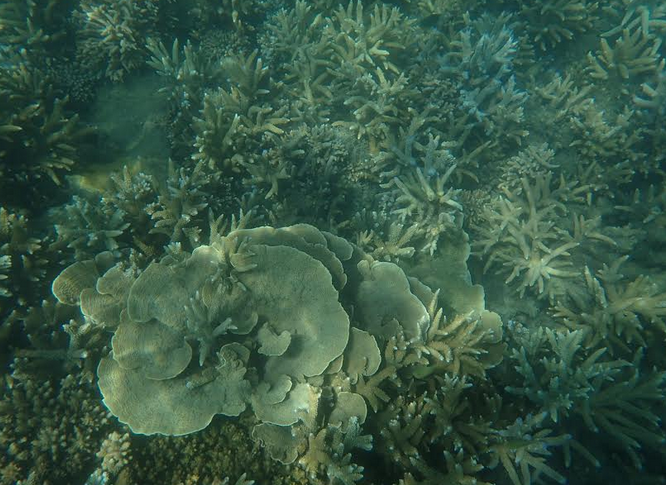
- Broad band of diverse luxuriant corals in Shoaswater Bay on E side of Stone Island
Just around the SE corner of the island from the fringing reef skirting the southern an south-eastern shore a 1.5Km wide bay fronts its eastern side. The water here is deeper and clearer. A broad band of diverse and luxuriant corals stretches across the entire bay (pictured below). Over much of this area coral coverage is near 100 per cent.
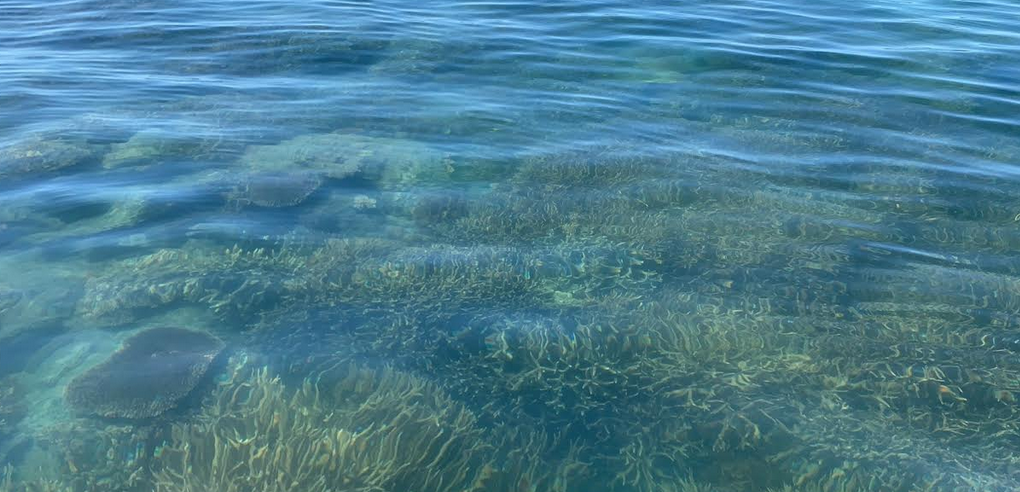
Extensive broad band of near 100% coral coverage across the entirety of Shoalwater Bay on the E. side of Stone I. Along both the southern and eastern shores of the island large windrows of coral rubble just above high tide level attest to the occasional effects of storms turning these reefs to rubble (below).
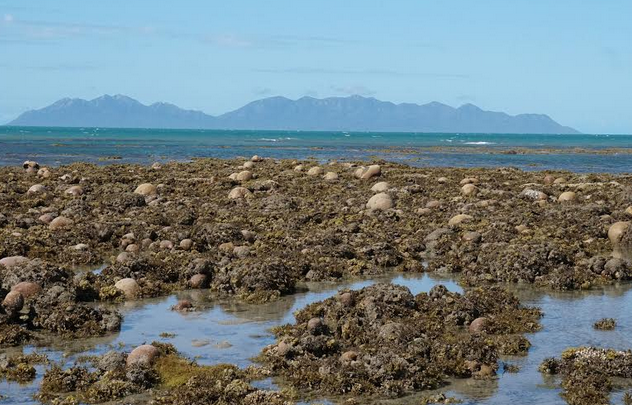
Elsewhere on the shallower northern and western sides of the island open sandy bottom limits reef development and corals are restricted to numerous small scattered bommies.
- Bramston Reef on the mainland shore
Along the southern side of the bay known as Port Denison, where Bowen is located, there is a wide, nearly Km wide shelf of coastal sand and mudflats (pictured below). For a couple of Km the outer edge of this shelf supports a fringing reef known as Bramston Reef. The conditions here are less favourable for corals and they are much less diverse and luxuriant in their development than at Stone Island. The survey by Clark et al. found mostly dead corals with little signs of recovery in 2012. We found numerous but scattered healthy heads of star corals not unlike the 19th century photos but without the scattered plate corals that were also present then. There were however scattered dead plate corals the condition of which indicated a recent period of recovery followed by another die off to which these more delicate species are particularly susceptible in such a marginal habitat. Just offshore from the outer edge of fringing reef there is also a scattering of large healthy coral bommies attesting to the ongoing long-term survival of a few species adapted to the rough turbid conditions of this location.

Kilometre wide sandflats at Port Denison with scattered small corals near shore. Stone Island, Gloucester I. and Cape Gloucester in background.
Multiple large colonies of living Favites corals along outer edge of Bramston Reef with Gloucester I. in the background.
- Several key things are apparent from what we found.
One is that the extensive areas of healthy and even luxuriant coastal reefs we found around Stone Island clearly refute any claims of declining water quality or climate change being responsible for dead corals found at environmental limits for corals where die-offs are common. Water quality and climate change would not affect corals in one place and leave extensive areas of diverse healthy reef immediately next to it.
The lack of any mention of the abundant healthy corals nearby poses the question of whether Clark et al. were they unaware of it, or did they deliberately choose to ignore it and in either case, why?
Establishment of government policy in response to activist campaigns and news media accounts of research claims with no critical assessment of the underlying research amounts to malfeasance and needs to be recognised as such.
Economic effects of misguided environmentalism
Meanwhile, despite all of the purported threats, the GBR remains a healthy vibrant natural community as can be attested by the thousands of visitors who enjoy its beauty every day. However, in addition to the hundreds of millions of dollars spent in devising hypothetical solutions to imaginary problems on the Reef, almost every productive economic activity in the region is being increasingly impacted by regulations and restrictions said to be necessary to “save” the Reef. Farming, grazing, mining, fishing, tourism, aquaculture and almost any kind of development are all paying a heavy price to prevent problems that can’t be shown to actually exist and for which there is no sound evidence of any measurable beneficial effect. However, unlike the imaginary threats, this is a real and present impact on the productive economy, and it is growing.
Worse, the situation with the GBR in regard to misguided environmentalism is only the tip of an iceberg having serious economic impacts both nationally and globally across Western culture. Over the past several decades in Australia unwarranted and ill-conceived environmental regulations have played a major role in driving two-thirds or more of small family operated primary producers from their industries. These were the low-overhead producers who provided some of the best and lowest cost food in the world. Increasingly they have been displaced by agribusinesses large enough to provide staff and economies of scale to deal with the regulatory morass. The result for consumers has been the greatest increase in food prices for an OECD nation.
And that’s just for food. Building materials, clothing, footwear, home appliances, furniture, tools, hardware and indeed almost every manufactured product has become increasingly or entirely dependent on imports, with environmental red tape and restrictions being a major driver of the move offshore.
Now, in an economy heavily dependent on minerals and natural gas, it is taking up to a decade for any large scale new projects to get through the approvals process. This entails a cost of hundreds of millions of dollars, ongoing high levels of uncertainty, frequent changes in demands and subjection to a constant barrage of highly publicised denigration and defamation from sundry activist campaigns. One can only wonder what the eco-activists imaging will continue to support them if they succeed in their demands.
The critical need for assessment and verification of research used for policy
While “quality control” may be a useful generic label for this issue, it does not convey to the non-scientist the actual nature of the problem and few have any undeerstanding of what constitutes quality science. In addition to replication, some other things of particular relevance to GBR research may be worth mentioning:
- Ignoring of conflicting evidence
- Misleading confidence levels and ignored uncertainties
- Selective use of data
- Improper employment of statistical methods
- Use of unvalidated modelling as evidence
- Undisclosed adjustments to data
- Provably false claims left unaddressed even when brought to attention.
Sound policy making demands the establishment of some mechanism to provide decision makers with a well-informed critical assessment of the science on which they rely. The current approach of presenting advocacy only, bolstered by claims of authority and consensus with no mention of uncertainty or conflicting evidence is simply not good enough for either decision making or even to be accepted as valid science.
A Senate inquiry might be a useful starting point, as it would not be too difficult to initiate and could provide a clearer recognition of the nature of the problem as well as how it might be effectively addressed. Focusing on GBR science initially could provide some clear examples and reduce the risk of diverging into multiple contentious issues resulting in no clear conclusions.
In view of the expanding social, economic and environmental challenges emerging from developments in energy, medicine, artificial intelligence, genetics, transportation, social media, immigration, education and sundry other fields it is going to be essential to good governance to develop the means to provide better informed decision making. This is not going to be just an optional extra. It is going to determine future national success or decline and separate the rising stars from the wannabees and hasbeens.
A marine biologist, Walter Starck has spent much of his career studying coral reef and marine fishery ecosystems
Academics and others who dare to question the majority view are brutally told the science has been settled. Many such dissenters from catastrophist orthodoxy have lost their jobs, been denied promotion, or subjected to constant harassment and ridicule. This not the way science should be done
Aug 25 2024
3 mins
There's a veritable industry of academics raising alarm about how global warming and a polluted, dying planet will leave humanity and the animal kingdom in such a state that cannibalism will be a matter of survival. I'll spurn schoolyard puns and cheap gags except for one, and that by way of good advice: don't give them a big hand
Aug 09 2024
13 mins
I thought initially that this topic was a bit of fun. But it turns out that entomophagy, as the eating of insects is called, is an essential component of the Western lemmings' race to net-zero. Need it be said that one of the biggest and most enthusiastic lemmings is our very own climate crazies at the CSIRO?
Jul 31 2024
15 mins







